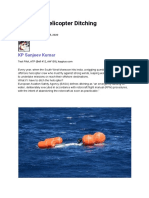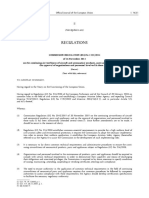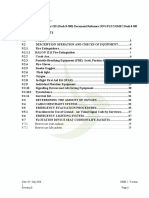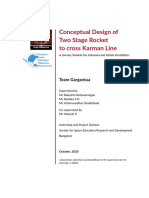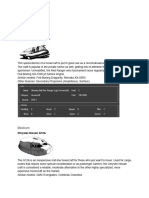Alert Service Bulletin: Emergency
Alert Service Bulletin: Emergency
Uploaded by
Aislan MendesCopyright:
Available Formats
Alert Service Bulletin: Emergency
Alert Service Bulletin: Emergency
Uploaded by
Aislan MendesOriginal Description:
Original Title
Copyright
Available Formats
Share this document
Did you find this document useful?
Is this content inappropriate?
Copyright:
Available Formats
Alert Service Bulletin: Emergency
Alert Service Bulletin: Emergency
Uploaded by
Aislan MendesCopyright:
Available Formats
EASB
EMERGENCY
ALERT SERVICE BULLETIN
SUBJECT: ENGINE CONTROLS - Twist grip
Functional check and installation of a protection for microswitches 53Ka and
53Kb and 65K (IDLE / FLIGHT mode)
Corresponds to modification 074699
ATA 76
For the attention of
AIRCRAFT Version(s)
NUMBER
CONCERNED Civil Military
AS350 05.00.61 B3
AS550 05.00.41 C3
EC130 05A009 B4
Revision No. Date of issue
Revision 0 (AS350 - EC130) 2009-11-16
Revision 1 (AS350 - EC130) Revision 0 (AS550) 2012-11-22
Revision 2 (AS350 - EC130) Revision 1 (AS550) 2013-08-13
Revision 3 (AS350 - EC130) Revision 2 (AS550) 2015-06-15
Summary:
The purpose of the previous revisions of this ALERT SERVICE BULLETIN was to:
- ensure correct operation of the controls on the twist grip
- apply a protective varnish to the microswitch connectors to make them water-tight
- introduce a new periodic check.
Reason for last Revision:
The purpose of this Revision is to add details concerning the varnish application procedure in order to make the
microswitch connectors water-tight.
Revision 3 (AS350 - EC130) and Revision 2 (AS550) affect compliance with the previous revisions of this ALERT
SERVICE BULLETIN.
Application:
Airbus Helicopters renders compliance with this ALERT SERVICE BULLETIN mandatory.
Revision 0 (350 - 130) 2009-11-16, Revision 0 (550) 2012-11-22 Page 1/16
Revision 3 (350 - 130), Revision 2 (550) 2015-06-15 This document is available on the internet: www.airbushelicopters.com/techpub
EASB
1. PLANNING INFORMATION
1.A. EFFECTIVITY
1.A.1. Helicopters/installed equipment
AS350 and AS550 helicopters equipped with the ARRIEL 2B1 engine (MOD 073254) associated with the
two-channel FADEC POST MOD 073261 (new twist grip).
EC130 helicopters equipped with the ARRIEL 2B1 engine associated with the two-channel FADEC POST
MOD 073773 (new twist grip).
NOTA 1
Refer to the aircraft individual inspection record (MOD record),
the equipment log cards (FMs) or the aircraft log book to identify
the actual configuration of the helicopter.
1.A.2. Non-installed equipment
Not applicable.
1.B. ASSOCIATED REQUIREMENTS
Not applicable.
1.C. REASON
Revision 0 and Revision 1:
During trouble-shooting analysis at the EUROCOPTER works, it was found that there is the risk of a dormant
failure of one of the two microswitches 53Ka or 53Kb following the introduction of modification 073254.
Failure of the other microswitch, associated with this dormant failure, can prevent switching from "IDLE"
mode to "FLIGHT" mode during training for autorotation, which can compel the pilot to continue autorotation
until the final phase.
EUROCOPTER consequently made it mandatory to check for correct opening and closing of the
microswitches 53Ka and 53Kb, in order to prevent this dormant failure.
Revision 2 (AS350 - EC130) or Revision 1 (AS550):
Following a recent incident (significant loss of power in flight) which occurred during an offshore flight, the
subsequent investigations and tests revealed that the operation of the implicated microswitches could be
altered due to environmental constraints (malfunction related to the possible presence of salt water on the
microswitch terminals).
Technical analysis revealed that modification 074263, introduced by ALERT SERVICE BULLETINS 80.00.09
(AS350), 80.00.06 (AS550), 80A005 (EC130) Revision 0, is necessary but does not enable cancellation of
the instructions given in this ALERT SERVICE BULLETIN. These instructions are therefore maintained for
concerned helicopters given in paragraph 1.A.1.
Revision 0 (350 - 130) 2009-11-16, Revision 0 (550) 2012-11-22 Page 2/16
Revision 3 (350 - 130), Revision 2 (550) 2015-06-15 This document is available on the internet: www.airbushelicopters.com/techpub
EASB
Consequently, the revision of this ALERT SERVICE BULLETIN takes into account the results of these latest
tests and renders the following mandatory:
- An extension of the effectivity for helicopters embodying modification 074263,
- A reduction of the time limit for first compliance and the periodic check to 330 flying hours,
- Removal/installation of the microswitch,
- A visual inspection to ensure there is no corrosion,
- Application of a varnish to make the microswitches water-tight,
- An electrical insulation check,
- A functional test for the correct opening and closing of the 53Ka, 53Kb and 65K microswitches.
Revision 3 (A350 - EC130) or Revision 2 (AS550):
Following feedback from some operators, complementary specifications have been added to the operational
procedure.
This Revision introduces modification 074699. It consists in ensuring water-tightness of the considered
microswitch connectors.
Moreover, the periodic check described in paragraph 1.E.2 is made applicable to helicopters POST
MOD 074699.
This Revision affects compliance with the previous revisions of this ALERT SERVICE BULLETIN.
1.D. DESCRIPTION
- A visual inspection to ensure there is no corrosion on the microswitches.
- Electrical test and check.
1.E. COMPLIANCE
1.E.1. Compliance at the works
Not applicable.
1.E.2. Compliance in service
Helicopters/installed equipment:
1.E.2.a. For all helicopters identified in paragraph 1.A.1. which do not embody modification 07-4699:
NOTA 2
Modification 07-4699 introduces the application of a protective
varnish in order to ensure water-tightness of the connectors of
microswitches 53Ka, 53Kb and 65K.
- Comply with paragraph 3 of this ALERT SERVICE BULLETIN in its latest revision within the
next 10 flying hours or 7 days (whichever limit comes first).
Revision 0 (350 - 130) 2009-11-16, Revision 0 (550) 2012-11-22 Page 3/16
Revision 3 (350 - 130), Revision 2 (550) 2015-06-15 This document is available on the internet: www.airbushelicopters.com/techpub
EASB
THEN
1) For the helicopters which operate or have operated since the previous compliance with
paragraph 3 of this ALERT SERVICE BULLETIN in salt laden conditions [salt laden conditions
persist when an aircraft is ship-based, based less than 1 km from the coast or performs an
offshore flight at low altitude (below 1,000 feet)]:
- Comply with paragraph 3. of this ALERT SERVICE BULLETIN every 330 flying hours or
6 months (whichever limit comes first).
OR
2) For the helicopters which do not operate and have never operated since the previous
compliance with paragraph 3 of this ALERT SERVICE BULLETIN in salt laden conditions:
- Comply with paragraph 3. of this ALERT SERVICE BULLETIN every 660 flying hours or
12 months (whichever limit comes first).
1.E.2.b. For all helicopters identified in paragraph 1.A.1. which embody modification 07-4699
1) For the helicopters which operate or have operated since embodiment of modification 07-4699
in salt laden conditions [salt laden conditions persist when an aircraft is ship-based, based less
than 1 km from the coast or performs an offshore flight at low altitude (below 1,000 feet)]:
- Comply with paragraph 3 of this ALERT SERVICE BULLETIN every 330 flying hours or 6
months since embodiment of modification 07-4699 (whichever limit comes first).
OR
2) For the helicopters which do not operate and have never operated since embodiment of
modification 07-4699 in salt laden conditions:
- Comply with paragraph 3 of this ALERT SERVICE BULLETIN every 660 flying hours or
12 months since embodiment of modification 07-4699 (whichever limit comes first).
Non-installed equipment:
Not applicable.
1.F. APPROVAL
Approval of modifications:
The information or instructions relate to modification 07-4699 which was approved on July 22, 2014 under
the authority of EASA Design Organization Approval No. 21J.056 for helicopters of civil versions subject to
an Airworthiness Certificate.
The information or instructions relate to modification 07-4699, which was approved on July 22, 2014 by the
Airbus Helicopters Airworthiness Department for export military versions.
Revision 0 (350 - 130) 2009-11-16, Revision 0 (550) 2012-11-22 Page 4/16
Revision 3 (350 - 130), Revision 2 (550) 2015-06-15 This document is available on the internet: www.airbushelicopters.com/techpub
EASB
Approval of this document:
The technical information contained in this ALERT SERVICE BULLETIN Revision 0 (AS350 - EC130) was
approved on November 12, 2009 under the authority of EASA Design Organization Approval No. 21J.056 for
helicopters of civil version subject to an Airworthiness Certificate.
The technical information contained in this ALERT SERVICE BULLETIN Revision 1 (AS350 - EC130) was
approved on November 20, 2012 under the authority of EASA Design Organization Approval No. 21J.056 for
helicopters of civil versions subject to an Airworthiness Certificate.
The technical information contained in this ALERT SERVICE BULLETIN Revision 0 (AS550) was approved
on November 20, 2012 by the EUROCOPTER Airworthiness Department for export military versions.
The technical information contained in this ALERT SERVICE BULLETIN (AS350 - EC130) Revision 2 was
approved on August 13, 2013 under the authority of EASA Design Organization Approval No. 21J.056 for
helicopters of civil versions subject to an Airworthiness Certificate.
The technical information contained in this ALERT SERVICE BULLETIN Revision 1 (AS550) was approved
on August 13, 2013 by the EUROCOPTER Airworthiness Department for export military versions.
The technical information contained in this ALERT SERVICE BULLETIN Revision 3 (AS350 - EC130) was
approved on June 15, 2015 under the authority of EASA Design Organization Approval No. 21J.056 for
helicopters of civil versions subject to an Airworthiness Certificate.
The technical information contained in this ALERT SERVICE BULLETIN Revision 2 (AS550) was approved
on June 15, 2015 by the Airbus Helicopters Airworthiness Department for export military versions.
1.G. MANPOWER
Qualification:
1 Avionics technician.
Time for the operations:
4 hours
Estimated helicopter grounding time:
1/2 day
1.H. WEIGHT AND BALANCE
Not applicable.
1.I. EFFECT ON ELECTRICAL LOADS
Not applicable.
1.J. SOFTWARE MODIFICATION EMBODIMENT RECORD
Not applicable.
Revision 0 (350 - 130) 2009-11-16, Revision 0 (550) 2012-11-22 Page 5/16
Revision 3 (350 - 130), Revision 2 (550) 2015-06-15 This document is available on the internet: www.airbushelicopters.com/techpub
EASB
1.K. REFERENCES
Aircraft Maintenance Manual (AMM):
- Task 24-00-00, 3-1.
- Task 53-51-00, 4-2.
- Task 76-12-03, 4-1
- Task 76-12-03, 4-1b
- Task 76-12-03, 5-1.
Standard Practices Manual (MTC):
- Work Card: 20.04.03.401
- Work Card: 20.04.03.103
1.L. DOCUMENTS AFFECTED
The following document will be the subject of a future update: AMM.
1.M. INTERCHANGEABILITY OR MIXABILITY OF PARTS
Not applicable.
Revision 0 (350 - 130) 2009-11-16, Revision 0 (550) 2012-11-22 Page 6/16
Revision 3 (350 - 130), Revision 2 (550) 2015-06-15 This document is available on the internet: www.airbushelicopters.com/techpub
EASB
2. MATERIAL INFORMATION
2.A. MATERIAL: PRICE - AVAILABILITY - PROCUREMENT
For any information on the price of components, contact the Airbus Helicopters Network Sales & Customer
Relations Department.
NOTE 1
On the purchase order, please specify the mode of transport,
the destination, and the serial numbers of the helicopters to be
modified.
NOTE 2
For ALERT SERVICE BULLETINS, order by:
Telex: HELICOP 410 969F
Fax: +33 (0)4.42.85.99.96.
2.B. INFORMATION CONCERNING INDUSTRIAL SUPPORT
For any information on technical assistance, contact the Airbus Helicopters Network Sales & Customer
Relations Department.
For any technical details, contact Airbus Helicopters Technical Support:
Fax: +33 (0)4 42 85 99 66
Email: Avionics.Technical-Support@eurocopter.com
2.C. MATERIAL REQUIRED FOR EACH HELICOPTER/COMPONENT
Products to be ordered separately:
As per Work Cards and Tasks mentioned in this ALERT SERVICE BULLETIN and the list below:
Material P/N Qty Item Key Word Former P/N Instruction
E0718-00-30 A/R 10 Heat-shrink sheath
E0718-02-30 A/R 11 Heat-shrink sheath
ECS2228.10 A/R 12 Vernelec 43022
varnish or equivalent
The products can be ordered separately, from the INTERTURBINE AVIATION LOGISTICS company:
Website: http://www.interturbine.com
Telephone: +49.41.91.809.300
AOG: +49.41.91.809.444
Revision 0 (350 - 130) 2009-11-16, Revision 0 (550) 2012-11-22 Page 7/16
Revision 3 (350 - 130), Revision 2 (550) 2015-06-15 This document is available on the internet: www.airbushelicopters.com/techpub
EASB
Tools:
Key Word Qty Part Number Item
Megohmmeter 1 Off the shelf zz
Ohmmeter 1 Off the shelf yy
2.D. MATERIAL TO BE RETURNED
Not applicable.
Revision 0 (350 - 130) 2009-11-16, Revision 0 (550) 2012-11-22 Page 8/16
Revision 3 (350 - 130), Revision 2 (550) 2015-06-15 This document is available on the internet: www.airbushelicopters.com/techpub
EASB
3. ACCOMPLISHMENT INSTRUCTIONS
3.A. GENERAL
CAUTION
APPLY THE ROTOR BRAKE TO PREVENT ANY RISK OF
STARTING.
Read and comply with the general instructions as per AMM Task 24-00-00, 3-1.
Carry out the check described below on the pilot’s and/or copilot’s side, according to the helicopter version.
3.B. OPERATIONAL PROCEDURE
3.B.1. Visual inspection of microswitches (Figure 1)
3.B.1.a. Removal of cowlings
- Remove the lower front cowling as per AMM Task 53-51-00, 4-2.
- Remove the protective cover (b).
3.B.1.b. Visual inspection
- Inspect the wiring side of microswitches (c), (d) and (e) in order to ensure that there are no marks, residues,
corrosion or flaky varnish (DETAIL A - Figure 1).
- If there are marks, residues, corrosion or flaky varnish, comply with paragraph 3.B.2.
- If there are no marks, residues, corrosion or flaky varnish, comply with paragraph 3.B.3.
3.B.2. Procedure in the event of marks, residues, corrosion or flaky varnish (Figures 1, 2, 3 and 4)
- Disconnect electrical connector 87DELTAP1 (a).
- Loosen and remove microswitches (c, d) and (e) as per AMM Task 76-12-03, 4-1 (AS350 and AS550) or
76-12-03, 4-1b (EC130).
- For each microswitch, note the position of the wires on the terminals.
- Remove and discard the sheath.
- Remove any varnish present.
- Unsolder the wires.
- Clean the wire side as per MTC Work Card 20.04.03.401 or 20.04.03.103.
As per Figure 3:
- Strip and tin the wires over a length of 4mm: Detail B.
- Position two pieces of sheath: one 10 mm piece of sheath (10) and one 8mm piece of sheath (11): Detail B.
- Preform the wire strands into a hook shape: Detail C.
- Position the preformed wire strands in the contact hole of the microswitch: Detail D.
- Solder using a soldering iron set to 340°C (tolerance -15°C to +30°C): Detail E.
- In order to protect them from corrosion, apply varnish (12) with a brush to (See Diagram - Figure 4):
. the soldered points of the electrical terminals,
. the unused terminals,
. the microswitch “heels” (area where the terminals are located).
Comply with MTC Work Card 20.04.03.103 without oven-drying the component: Detail E.
- Leave to dry until the varnish hardens.
- Position the sheath (10) against the soldered area and shrink fit it: Detail E.
- Position the sheath (11) against the microswitch over sheath (10) and shrink fit it: Detail F.
Revision 0 (350 - 130) 2009-11-16, Revision 0 (550) 2012-11-22 Page 9/16
Revision 3 (350 - 130), Revision 2 (550) 2015-06-15 This document is available on the internet: www.airbushelicopters.com/techpub
EASB
CAUTION
WHEN INSTALLING THE MICROSWITCHES (C, D) AND (E),
TORQUE TIGHTEN TO A VALUE BETWEEN 0.25 AND
0.3 N.M (2.21 - 2.65 IN.LB).
- Install microswitches (c, d) and (e) as per AMM Task 76-12-03, 4-1 (AS350 and AS550) or 76-12-03, 4-1b
(EC130).
- Carry out an insulation test as per paragraph 3.B.3.
3.B.3. Insulation test (Figures 1 and 2)
- If not previously disconnected, disconnect electrical connector 87DELTAP1 (a).
- Carry out an electrical insulation test at 50 volts using a megohmmeter (zz) connected between:
. the housing of microswitch 53Ka and terminals A and B of connector 87DELTAP1.
. the housing of microswitch 53Kb and terminals D and F of connector 87DELTAP1.
. the housing of microswitch 65K and terminals D and E of connector 87DELTAP1.
Interpretation of the results:
a) If the values displayed are more than or equal to 10 MΩ, comply with paragraph 3.B.4.
b) If the values displayed are less than 10 MΩ:
Loosen, remove and then discard the concerned microswitch(es) as per AMM Task 76-12-04, 4-1.
Install a new microswitch.
Note the position of the wires on the terminals.
Remove and discard the sheath.
Remove any varnish present.
Unsolder the wires.
As per Figure 3 :
Strip and tin the wires over a length of 4mm: Detail B.
Position two pieces of sheath: one 10mm piece of sheath (10) and one 8mm piece of sheath (11):
Detail B.
Preform the wire strands into a hook shape: Detail C.
Position the preformed wire strands in the contact hole of the microswitch: Detail D.
Solder using a soldering iron set to 340°C (tolerance -15°C to +30°C): Detail E.
In order to protect them from corrosion, apply varnish (12) with a brush to (See Diagram - Figure 4):
the soldered points of the electrical terminals,
unused terminals,
the microswitch “heels” (area where the terminals are located).
Comply with MTC Work Card 20.04.03.103 without oven-drying the component: Detail E.
Allow to dry until the varnish hardens.
Position the sheath (10) against the soldered area and shrink fit it: Detail E.
Position the sheath (11) against the microswitch over sheath (10) and shrink fit it: Detail F.
Revision 0 (350 - 130) 2009-11-16, Revision 0 (550) 2012-11-22 Page 10/16
Revision 3 (350 - 130), Revision 2 (550) 2015-06-15 This document is available on the internet: www.airbushelicopters.com/techpub
EASB
CAUTION
WHEN INSTALLING THE MICROSWITCH, TORQUE
TIGHTEN TO A VALUE BETWEEN 0.25 AND 0.3 N.M (2.21 -
2.65 IN.LB).
Install the microswitch(es) concerned as per AMM Task 76-12-04, 4-1.
Carry out a new insulation test.
Then comply with paragraph 3.B.4.
3.B.4. Checking the IDLE and FLIGHT controls on the pilot’s and copilot’s twist grips (Figure 2)
- Connect an ohmmeter (yy) to terminals A and B of connector 87DELTAP1.
- Turn the twist grip from "IDLE" to "FLIGHT" and from "FLIGHT" to "IDLE":
. Check on the ohmmeter (yy) that the microswitch closes in the "IDLE" position and opens as soon as the
twist grip is turned from the “IDLE” position to the "FLIGHT" position.
. If the check result is not correct, replace the microswitch concerned by carrying out the procedure
described in paragraph 3.B.3.b).
- Disconnect the ohmmeter (yy) and connect it to terminals D and F of connector 87DELTAP1.
- Turn the twist grip from "IDLE" to "FLIGHT" and from "FLIGHT" to "IDLE":
. Check on the ohmmeter (yy) that the microswitch closes in the "IDLE" position and opens as soon as the
twist grip is turned from the “IDLE” position to the "FLIGHT" position.
. If the check result is not correct, replace the microswitch concerned by carrying out the procedure
described in paragraph 3.B.3.b).
- Disconnect the ohmmeter (yy) and connect it to terminals D and E of connector 87DELTAP1.
- Turn the twist grip from "IDLE" to "FLIGHT" and from "FLIGHT" to "IDLE":
. Check on the ohmmeter (yy) that the microswitch closes in the "IDLE" position and opens as soon as the
twist grip is turned from the “IDLE” position to the "FLIGHT" position.
. If the check result is not correct, replace the microswitch concerned by carrying out the procedure
described in paragraph 3.B.3.b).
- Disconnect the ohmmeter (yy).
- Connect the electrical connector 87DELTAP1 (a).
- Carry out the appropriate procedure as defined in the table below:
Compliance with Replacement of
Required procedure
paragraph 3.B.2 microswitch
YES NO Comply with paragraph 3.B.6
YES YES Comply with paragraph 3.B.5
PRE MOD 074699, comply with paragraph 3.B.5
NO NO
POST MOD 074699, comply with paragraph 3.B.6
NO YES Comply with paragraph 3.B.5
Revision 0 (350 - 130) 2009-11-16, Revision 0 (550) 2012-11-22 Page 11/16
Revision 3 (350 - 130), Revision 2 (550) 2015-06-15 This document is available on the internet: www.airbushelicopters.com/techpub
EASB
3.B.5. Application of varnish (Figures 3 and 4)
NOTE 1
Revision 2 required the application of varnish to the soldered
points and unused terminals only. The procedure described
below ensures water-tightness of the microswitch by application
of varnish to the heel.
- Apply varnish (12) with a brush to (See Diagram - Figure 4):
the soldered points of the electrical terminals,
the unused terminals,
the microswitch “heels” (area where the terminals are located).
- Comply with MTC Work Card 20.04.03.103 without oven-drying the component: Detail E.
- Allow to dry until the varnish hardens.
- Comply with paragraph 3.B.6.
3.B.6. Tests
- Install the protective cover (b) Figure 2.
- Install the front lower cowling as per AMM Task 53-51-00, 4-2.
- Conduct the operational tests and indicating tests of the twist grip as per AMM Task 76-12-03, 5-1.
3.C. IDENTIFICATION
Identification of the modification:
Record the embodiment of modification 07-4699 in the helicopter documents upon first compliance with this
document.
Identification of this document:
Record first compliance with this document in the helicopter documents.
3.D. OPERATING AND MAINTENANCE INSTRUCTIONS
Not applicable.
4. ANNEXE
Not applicable.
Revision 0 (350 - 130) 2009-11-16, Revision 0 (550) 2012-11-22 Page 12/16
Revision 3 (350 - 130), Revision 2 (550) 2015-06-15 This document is available on the internet: www.airbushelicopters.com/techpub
EASB
0.25 - 0.3
2.21 - 2.65 b
A
DETAIL A
Figure 1
Revision 0 (350 - 130) 2009-11-16, Revision 0 (550) 2012-11-22 Page 13/16
Revision 3 (350 - 130), Revision 2 (550) 2015-06-15 This document is available on the internet: www.airbushelicopters.com/techpub
EASB
Figure 2: Electrical continuity test of microswitches 53Ka, 53Kb and 65K
Revision 0 (350 - 130) 2009-11-16, Revision 0 (550) 2012-11-22 Page 14/16
Revision 3 (350 - 130), Revision 2 (550) 2015-06-15 This document is available on the internet: www.airbushelicopters.com/techpub
EASB
10 11
D E
12
F
Figure 3
Revision 0 (350 - 130) 2009-11-16, Revision 0 (550) 2012-11-22 Page 15/16
Revision 3 (350 - 130), Revision 2 (550) 2015-06-15 This document is available on the internet: www.airbushelicopters.com/techpub
EASB
12
Figure 4
Revision 0 (350 - 130) 2009-11-16, Revision 0 (550) 2012-11-22 Page 16/16
Revision 3 (350 - 130), Revision 2 (550) 2015-06-15 This document is available on the internet: www.airbushelicopters.com/techpub
You might also like
- All About M KiiiDocument90 pagesAll About M Kiiisudhiruday31No ratings yet
- S92 Operators HandbookDocument5 pagesS92 Operators Handbookcleitom6547686754354No ratings yet
- EC120 Transition Pilot - POIDocument7 pagesEC120 Transition Pilot - POI唐波100% (1)
- CSL 1001Document11 pagesCSL 1001oscar horacio floresNo ratings yet
- Flight Safety Analysis Handbook Final 9 2011v1Document224 pagesFlight Safety Analysis Handbook Final 9 2011v1blackhawk100% (1)
- Bell206 Emergency Procedure PDFDocument11 pagesBell206 Emergency Procedure PDFupali01No ratings yet
- International Case Study III-5: China Airlines Flight CI-012Document9 pagesInternational Case Study III-5: China Airlines Flight CI-012Nguyễn ChínhNo ratings yet
- Airman Certification Standards: Airline Transport Pilot and Type Rating - Airplane (2025): FAA-S-ACS-11AFrom EverandAirman Certification Standards: Airline Transport Pilot and Type Rating - Airplane (2025): FAA-S-ACS-11ANo ratings yet
- Rotor Magazine 111Document32 pagesRotor Magazine 111articnorth141No ratings yet
- Brochure Entrol H12 FNPT II MCCDocument12 pagesBrochure Entrol H12 FNPT II MCCAbdoulrazack NaguibNo ratings yet
- Travis Aero Club Open Book TestDocument7 pagesTravis Aero Club Open Book TestMayank VatsNo ratings yet
- 4 Rotors European Rotor JournalDocument48 pages4 Rotors European Rotor JournalFatih AkgülNo ratings yet
- 137534991-15 Aircraft FuellingDocument14 pages137534991-15 Aircraft FuellingTDHNo ratings yet
- Overview of The HelicopterDocument12 pagesOverview of The HelicopterclebersjcNo ratings yet
- BLR 412FF 950 PDFDocument17 pagesBLR 412FF 950 PDFGhulam MustafaNo ratings yet
- Cost-Effective, Off-the-Shelf Commercial Re-Engining: Turbofan EngineDocument2 pagesCost-Effective, Off-the-Shelf Commercial Re-Engining: Turbofan EngineStrawichDanielNo ratings yet
- FlightGear Keyboard MapDocument6 pagesFlightGear Keyboard MaprunohojoruNo ratings yet
- Hydraulic Control SystemsDocument15 pagesHydraulic Control SystemsRon McIntyreNo ratings yet
- BLR 212Document8 pagesBLR 212Karadias100% (1)
- Helicopter Operations: Frequently Asked QuestionsDocument4 pagesHelicopter Operations: Frequently Asked QuestionsFERNANDONo ratings yet
- 05 - Scheduled - Unscheduled MaintenanceDocument14 pages05 - Scheduled - Unscheduled MaintenanceEsang Akan100% (1)
- 00 - Helicopter GeneralDocument146 pages00 - Helicopter GeneralKerlos SaidNo ratings yet
- AGREEdisagree ICAOGODocument14 pagesAGREEdisagree ICAOGOJoao Paulo de Sousa SilvaNo ratings yet
- Helicopter: For Other Uses, SeeDocument18 pagesHelicopter: For Other Uses, SeeloveleensharmaNo ratings yet
- Helicopter Final PresentationDocument28 pagesHelicopter Final Presentationbib demNo ratings yet
- Surviving Helicopter DitchingDocument6 pagesSurviving Helicopter DitchingbkmaverikNo ratings yet
- Datasheet - Assignment of Icao Aircraft Types To Recat-Eu Wake TurbulencDocument87 pagesDatasheet - Assignment of Icao Aircraft Types To Recat-Eu Wake TurbulencIvanna JimenezNo ratings yet
- Technical Data: EurocopterDocument67 pagesTechnical Data: Eurocopterguillermo garcia100% (1)
- 505 Bro 012014EN WEB PDFDocument2 pages505 Bro 012014EN WEB PDFigorsouzNo ratings yet
- Elliptical Winglets: The World'S Fastest Business Jet Just Got BetterDocument2 pagesElliptical Winglets: The World'S Fastest Business Jet Just Got BetterDeepak GaurNo ratings yet
- 690-5 - Helicopter and EquipmentDocument23 pages690-5 - Helicopter and EquipmentДмитрий SolodNo ratings yet
- Regulation 1321 2014 On The Continuing Airworthiness of Aircraft en PDFDocument194 pagesRegulation 1321 2014 On The Continuing Airworthiness of Aircraft en PDFmechNo ratings yet
- Aim 2023Document491 pagesAim 2023logancreighton51No ratings yet
- H88EU Rev14Document14 pagesH88EU Rev14Aerospace Technical AcademyNo ratings yet
- Engr 6421 - Final - Project - GR - 19Document65 pagesEngr 6421 - Final - Project - GR - 19Noel DsouzaNo ratings yet
- Spectrum BrochureDocument16 pagesSpectrum BrochuredimdamflyNo ratings yet
- AS350 B3 UtilityDocument4 pagesAS350 B3 Utilitygarcheti100% (1)
- AH EC120B Technical DataDocument54 pagesAH EC120B Technical DataHelimanualNo ratings yet
- Chapter 9 - Emergency Equipment and Evacuation ProceduresDocument41 pagesChapter 9 - Emergency Equipment and Evacuation ProceduresKelvinNo ratings yet
- 212 FM Caa 01 S01Document22 pages212 FM Caa 01 S01Barajas LE ParkeNo ratings yet
- India Helicopter FOMDocument28 pagesIndia Helicopter FOMRaviNo ratings yet
- Director General of Civil Aviation: Operations Circular No. 2 of 2004Document3 pagesDirector General of Civil Aviation: Operations Circular No. 2 of 2004FARAAZNo ratings yet
- Certificado Tipo Bell 204Document10 pagesCertificado Tipo Bell 204maocartoNo ratings yet
- 2010 Bambi Bucket Operations Manual Ve (All Models)Document26 pages2010 Bambi Bucket Operations Manual Ve (All Models)rubenarisNo ratings yet
- Assignment B 1Document4 pagesAssignment B 1José A. Montiel QuirósNo ratings yet
- Aeronautical Information Lexicon Aicm For The Aeronautical Information Conceptual ModelDocument9 pagesAeronautical Information Lexicon Aicm For The Aeronautical Information Conceptual ModelWilfredo CallisayaNo ratings yet
- 01 Phak FrontDocument7 pages01 Phak FrontIan UdhiliNo ratings yet
- Sa227 SeriesDocument20 pagesSa227 SeriesRicardo zafraNo ratings yet
- bh-212-412 - Rev 9 PDFDocument56 pagesbh-212-412 - Rev 9 PDFJuan Andrés Ordoñez SaavedraNo ratings yet
- JAR 66 PART 66 DifferencesDocument39 pagesJAR 66 PART 66 DifferencesmansorhayonNo ratings yet
- FAA Helicopters - Chapter 06 - Weight and BalanceDocument6 pagesFAA Helicopters - Chapter 06 - Weight and BalanceFernando Torquato LeiteNo ratings yet
- Bell 206 - Wikipedia, The Free EncyclopediaDocument13 pagesBell 206 - Wikipedia, The Free EncyclopediaAmy Klezan100% (1)
- Bell 429 WLGDocument19 pagesBell 429 WLGjohnNo ratings yet
- Cabri G2 Pilots Training Handbook AV8Document35 pagesCabri G2 Pilots Training Handbook AV8Yong HanNo ratings yet
- "Super Puma": Instruction ManualDocument2 pages"Super Puma": Instruction ManualNightIntruder0% (1)
- Series - TDocument10 pagesSeries - TAryan LahariaNo ratings yet
- ICAO Rescue Fire Fighting (RFF) Category Compliance at AirportsDocument2 pagesICAO Rescue Fire Fighting (RFF) Category Compliance at Airportsluka_estNo ratings yet
- Robinson Series 22 - 44Document39 pagesRobinson Series 22 - 44Oscar Arias100% (1)
- AW139 EMS Brochure - Gen2020 PDFDocument5 pagesAW139 EMS Brochure - Gen2020 PDFခန့်ဇော်ဟိဏ်းNo ratings yet
- TP876E - Study & Ref Guide Glider PilotDocument20 pagesTP876E - Study & Ref Guide Glider PilotbahbahaNo ratings yet
- Airman Certification Standards: Commercial Pilot - Helicopter (2025): FAA-S-ACS-16From EverandAirman Certification Standards: Commercial Pilot - Helicopter (2025): FAA-S-ACS-16No ratings yet
- Design of Low Altitude Long Endurance Solar-Powered UAV Using Genetic AlgorithmDocument24 pagesDesign of Low Altitude Long Endurance Solar-Powered UAV Using Genetic Algorithm이재국No ratings yet
- Team Gargatua ReportDocument50 pagesTeam Gargatua ReportGokulNo ratings yet
- IYE - A330 - IPC - 01-Jul-2023 - FIG. 53-35-03-12B - PLATE INSTL (Apr 01 - 22)Document9 pagesIYE - A330 - IPC - 01-Jul-2023 - FIG. 53-35-03-12B - PLATE INSTL (Apr 01 - 22)aalkamisNo ratings yet
- 07 Lifting & ShoringDocument12 pages07 Lifting & ShoringMohamed OussaidNo ratings yet
- Radio-Controlled Helicopter: Navigation Search Merged Discuss List of References External Links ImproveDocument10 pagesRadio-Controlled Helicopter: Navigation Search Merged Discuss List of References External Links ImproveBijesh JayanNo ratings yet
- Living in a Space Station American English TeacherDocument12 pagesLiving in a Space Station American English Teacheranghel alexandraNo ratings yet
- SW 18 29Document5 pagesSW 18 29Thamer SanouchiNo ratings yet
- 2022-03-30 ICAO NOTAM 101 Presentation For Airport OperatorsDocument34 pages2022-03-30 ICAO NOTAM 101 Presentation For Airport OperatorsRafiaa Al SharafNo ratings yet
- Equipment, Navigation and FacilitiesDocument9 pagesEquipment, Navigation and FacilitiesJuly TadeNo ratings yet
- Breifing NotesDocument1 pageBreifing NotesMohamed SamirNo ratings yet
- Advanced Low-Noise Aircraft Configurations and Their Assessment: Past, Present, and FutureDocument30 pagesAdvanced Low-Noise Aircraft Configurations and Their Assessment: Past, Present, and FutureFirliandini Pralinda SundariNo ratings yet
- S1 GE Paper Term OneDocument12 pagesS1 GE Paper Term Onec21fw.csyNo ratings yet
- Grumman Sa-16 & Uf AlbatrossDocument5 pagesGrumman Sa-16 & Uf AlbatrossGiora MinorNo ratings yet
- OccurrenceDocument4 pagesOccurrenceFemi AgbanaNo ratings yet
- ICAO IATA and Aircraft CodesDocument46 pagesICAO IATA and Aircraft CodesScribdTranslationsNo ratings yet
- Easa TCDS A.364 - Grob - G - 115 02 20122011Document43 pagesEasa TCDS A.364 - Grob - G - 115 02 20122011Albaz DarwishNo ratings yet
- Highspeed Flight - Transonic Regime Lesson 1Document24 pagesHighspeed Flight - Transonic Regime Lesson 1MarvinNo ratings yet
- Water Rocket Launch: Lesson FocusDocument18 pagesWater Rocket Launch: Lesson FocusShahood AqilNo ratings yet
- A Design Method For Supersonic Transport WingsDocument11 pagesA Design Method For Supersonic Transport Wings李子木No ratings yet
- Question Bank - AEDDocument3 pagesQuestion Bank - AEDbhuvan raju t kNo ratings yet
- Pdfcoffee.com Right on 4 Test 3a PDF FreeDocument7 pagesPdfcoffee.com Right on 4 Test 3a PDF FreeyvonnecarlileestebanNo ratings yet
- Helicopdes PPT 7 Basic Helicopter AerodynamicsDocument46 pagesHelicopdes PPT 7 Basic Helicopter AerodynamicsastroNOT100% (2)
- Rigger 5.5Document142 pagesRigger 5.5bismarckinmotionkingoftheoceanNo ratings yet
- Jar 145 Approved Maintenance OrganisationsDocument87 pagesJar 145 Approved Maintenance OrganisationsMohamed NasirNo ratings yet
- MAA - ATO Flight Instructor Guide Whiteboard LayoutsDocument32 pagesMAA - ATO Flight Instructor Guide Whiteboard LayoutsEnkhjiguur GanboldNo ratings yet
- AIRBUS H145 (BK117 D2) Helicopter ChecklistDocument3 pagesAIRBUS H145 (BK117 D2) Helicopter ChecklisthelloNo ratings yet
- Plane & Pilot. 10 (2017)Document68 pagesPlane & Pilot. 10 (2017)Marcelo MartinsNo ratings yet
- Checklist A340 600Document1 pageChecklist A340 600nksfzq5b6rNo ratings yet


























